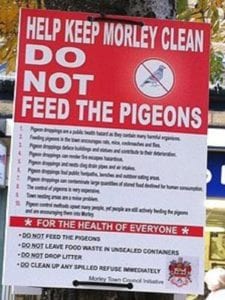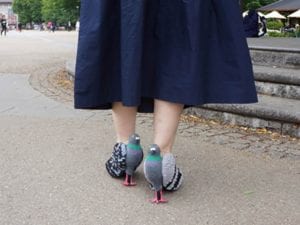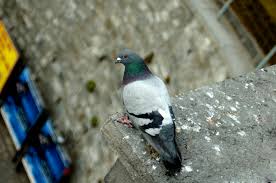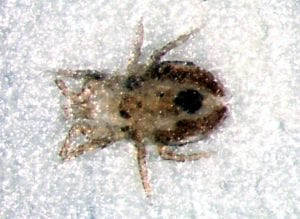
by Pigeon Patrol | Mar 4, 2020 | 4-S Gel Bird repellent, Animal Deterrent Products, Bird Deterrent Products, Bird Netting, Bird Spike, Bird Spikes, Pigeon Control, Pigeon Droppings, Pigeon Patrol's Services, Pigeon Spikes, Pigeons in the News, UltraSonic Bird Control
Town Council agrees pigeons cull
A cull of pigeons has been approved at a meeting of a West Yorkshire town council.
Bird droppings have caused £50,000 of damage to Morley Town Hall by blocking drains which have caused flooding.
People have been told not to feed the problem birds and now council officials say that they have to decide on the most effective method.
The Pigeon Control Advisory Service told the BBC that culling “causes the birds to rebreed”.
“We are not throwing away our rubbish properly and we’re feeding them over and above what they need,” said Emma Haskell, of the Pigeon Control Advisory Service.
“The key message is to stop feeding them.”
‘Ate alive’
Ms Haskell said that in the USA, contraceptives were fed to birds to control their population, but they were not used in the UK because contraceptives had not been proven to be an effective method of control.
Elsewhere in the UK, councils have used birds of prey to keep the pigeon population at bay, but Ms Haskell said this was not recommended either.
“The peregrine falcon is the pigeon’s natural predator, not the Harris hawk which is commonly used,” she said.
“Pigeons fly a lot faster than the Harris hawk and it will only ever catch young, injured or sick pigeons.
“There was outrage in Norwich when a Harris hawk flew down and ate alive a pigeon in the middle of the town centre. It was all very upsetting.”
Source
At Pigeon Patrol, we manufacture and offer a variety of bird deterrents, ranging from Ultra-flex Bird Spikes with UV protection, Bird Netting, 4-S Gel and the best Ultrasonic and audible sound devices on the market today.
Contact us at 1- 877– 4– NO-BIRD, (604) 585-9279 or visit our website at www.pigeonpatrol.ca
Bird Gone, Pigeon Gone, Seagull Gone, Pigeon issue, pigeon spikes, 1-877-4NO-BIRD, 4-S Gel, Bird Control, Pigeon Control, bird repellent, Bird Spikes, sonic bird repellent, stainless steel bird spikes, bird spikes Vancouver, Ultra Sonic Bird Control, Bird Netting, Plastic Bird Spikes, Canada bird spike deterrents, Pigeon Pests, B Gone Pigeon, Pigeon Patrol, pest controller, pest control operator, pest control technician, Pigeon Control Products, humane pigeon spikes, pigeon deterrents, pigeon traps, Pigeon repellents, Sound & Laser Deterrents, wildlife control, raccoon, skunk, squirrel deterrent, De-Fence Spikes, Dragons Den, Canada bird spikes, Canada pigeon, pigeon control, pigeon patrol, pigeon. Kill pigeons, crow, starling

by Pigeon Patrol | Mar 4, 2020 | 4-S Gel Bird repellent, Animal Deterrent Products, Bird Deterrent Products, Bird Netting, Bird Spike, Bird Spikes, Pigeon Control, Pigeon Droppings, Pigeon Patrol's Services, Pigeon Spikes, Pigeons in the News, UltraSonic Bird Control
The in-toeing epidemic (pigeon toed gait) – estrogen?
The mystery of the in-toeing (pigeon toed) epidemic among young women continues:
http://charltonteaching.blogspot.com/2010/09/pigeon-toed-gait-endemic-among.html
(I am convinced that this gait is not an affectation – I am sure it is involuntary in most instances.)
The best suggested explanation came from Paul Jaminet – vitamin D deficiency; with its bone-softening effects.
This suggests that in-toeing may be a result of softening of the feet, in some way, shape or form; if not bones them perhaps joints?…
Which then leads on to the idea that it might be due to some increase in estrogen – whether natural, in contraceptives, or as an environmental pollutant (which may explain why surprising numbers of men walk this way too).
The only ‘evidence’ I can present for this is that estrogen softens and loosens joints (i.e. softening the ligaments that join bones to bones – this is well known in pregnancy) – perhaps making the ankles or internal joints of the foot more ‘floppy’, and hyper-flexible feet may cause the observed change in gait?
Well, I’m not very convinced by this – but the phenomenon is real and new, and there must be some explanation!
NOTE added – on further reflection I think the problem is likely to be neural – neuromuscular – rather than musculoskeletal – and subtly neuromuscular – hence perhaps related to basal ganglia dysfunction.
What ever causes basal ganglion dysfunction might be environmental toxins of some sort; but could also be infective – as many new diseases eventually turn-out to be.
Source
At Pigeon Patrol, we manufacture and offer a variety of bird deterrents, ranging from Ultra-flex Bird Spikes with UV protection, Bird Netting, 4-S Gel and the best Ultrasonic and audible sound devices on the market today.
Contact us at 1- 877– 4– NO-BIRD, (604) 585-9279 or visit our website at www.pigeonpatrol.ca
Bird Gone, Pigeon Gone, Seagull Gone, Pigeon issue, pigeon spikes, 1-877-4NO-BIRD, 4-S Gel, Bird Control, Pigeon Control, bird repellent, Bird Spikes, sonic bird repellent, stainless steel bird spikes, bird spikes Vancouver, Ultra Sonic Bird Control, Bird Netting, Plastic Bird Spikes, Canada bird spike deterrents, Pigeon Pests, B Gone Pigeon, Pigeon Patrol, pest controller, pest control operator, pest control technician, Pigeon Control Products, humane pigeon spikes, pigeon deterrents, pigeon traps, Pigeon repellents, Sound & Laser Deterrents, wildlife control, raccoon, skunk, squirrel deterrent, De-Fence Spikes, Dragons Den, Canada bird spikes, Canada pigeon, pigeon control, pigeon patrol, pigeon. Kill pigeons, crow, starling

by Pigeon Patrol | Mar 4, 2020 | 4-S Gel Bird repellent, Animal Deterrent Products, Bird Deterrent Products, Bird Netting, Bird Spike, Bird Spikes, Pigeon Control, Pigeon Droppings, Pigeon Patrol's Services, Pigeon Spikes, Pigeons in the News, UltraSonic Bird Control
Pigeon races up in the sky!
Pigeon racers from far afield have their eyes on Tasmania.
Avid pigeon racers are trying to establish a contest that rivals the great long distance, cross water, pigeon races held around the world.
Experienced fliers, George Rettas and Alex MacDonald and other enthusiasts organised the ‘Conquer the Strait’ one loft race from Perth in northern Tasmania.
The idea of the ‘Conquer the Strait’ challenge is to test some of Australia’s best racing pigeons over one of the roughest stretches of water in the world.
The race was designed for the birds to fly over more than 500 kilometres from south western Victoria, including over 300 kilometres of Bass Strait.
And while an outbreak of the paramixovirus in Victorian pigeons curtailed the inaugural race in October 2011, a shortened race format over 220 kilometres from Woolnorth to Perth was held.
Pigeon racers from far afield joined the Tasmanian long distance enthusiasts who were out to prove they have the best birds on earth.
Source
At Pigeon Patrol, we manufacture and offer a variety of bird deterrents, ranging from Ultra-flex Bird Spikes with UV protection, Bird Netting, 4-S Gel and the best Ultrasonic and audible sound devices on the market today.
Contact us at 1- 877– 4– NO-BIRD, (604) 585-9279 or visit our website at www.pigeonpatrol.ca
Bird Gone, Pigeon Gone, Seagull Gone, Pigeon issue, pigeon spikes, 1-877-4NO-BIRD, 4-S Gel, Bird Control, Pigeon Control, bird repellent, Bird Spikes, sonic bird repellent, stainless steel bird spikes, bird spikes Vancouver, Ultra Sonic Bird Control, Bird Netting, Plastic Bird Spikes, Canada bird spike deterrents, Pigeon Pests, B Gone Pigeon, Pigeon Patrol, pest controller, pest control operator, pest control technician, Pigeon Control Products, humane pigeon spikes, pigeon deterrents, pigeon traps, Pigeon repellents, Sound & Laser Deterrents, wildlife control, raccoon, skunk, squirrel deterrent, De-Fence Spikes, Dragons Den, Canada bird spikes, Canada pigeon, pigeon control, pigeon patrol, pigeon. Kill pigeons, crow, starling

by Pigeon Patrol | Mar 4, 2020 | 4-S Gel Bird repellent, Animal Deterrent Products, Bird Deterrent Products, Bird Netting, Bird Spike, Bird Spikes, Pigeon Control, Pigeon Droppings, Pigeon Patrol's Services, Pigeon Spikes, Pigeons in the News, UltraSonic Bird Control
Pigeon fever is an equine disease that doesn’t have anything to do with pigeons. It’s an infection caused by the bacterium Corynebacterium pseudotuberculosis which results in the formation of abscesses, usually along the chest (pectoral region) and lowest part of the abdomen. The name “pigeon fever” comes from the swelling in the chest region that vaguely resembles a pigeon-breast. A recent report describes and outbreak of pigeon fever involving at least 30 horses in Louisiana, bringing the estimated number of cases in the state in 2011 to over 100.
Pigeon fever is a regionally (and to a lesser degree seasonally) variable disease. It predominantly occurs in California, but over recent years it has expanded its range in the western US, and from this report, it’s obvious that it has a good foothold in some other areas in the south east as well. 
Corynebacterium pseudotuberculosis lives in the soil, and causes infections in horses when it gets inoculated under the skin via wounds and perhaps sometimes through fly bites. Once it gets into the tissues, it starts to grow and causes painful (and potentially large) abscesses that often need to be surgically incised in order to drain them.
Infection control practices on farms can help reduce transmission of the bacterium between horses and to reduce the risk of injuries. These include:
- Quarantine of new arrivals and careful inspection for sign of infection.
- Isolation of known infected horses.
- Use of “contact precautions” when dealing with infected horses to prevent transmission of the bacterium via peoples’ bodies or clothing. This involves the use of protective outwear (e.g. coveralls and boots that are only used for the infected horse(s)) and gloves.
- Proper use of handwashing / hand sanitizer by people handling infected horses (or any horses, really, from a broader standpoint).
- Prevention of cross-use of items like buckets between infected/quarantined horses and the general horse population.
- Use of fly repellent, especially on horses with open wounds or draining abscesses.
- Careful cleaning and disinfection of areas potentially contaminated by pus from draining abscesses.
- Inspection of stalls, paddocks and fields for things that could cause wounds that might subsequently become infected.
Pigeon fever is a good example of why it’s important to know disease patterns in your region (and those to where your horses travel). Being aware of the possibility of a specific disease is an important step in diagnosis, and knowing there is disease activity in any area in which your horse may have been is a key part of that. This disease is also an example of why we need ongoing disease surveillance and reporting, because if a disease makes it into new regions, veterinarians and horse owners need to know about that as soon as possible to allow for quicker diagnosis and use of control measures. Unfortunately, organized disease surveillance and communication is sorely lacking in horses.
Source
At Pigeon Patrol, we manufacture and offer a variety of bird deterrents, ranging from Ultra-flex Bird Spikes with UV protection, Bird Netting, 4-S Gel and the best Ultrasonic and audible sound devices on the market today.
Contact us at 1- 877– 4– NO-BIRD, (604) 585-9279 or visit our website at www.pigeonpatrol.ca
Bird Gone, Pigeon Gone, Seagull Gone, Pigeon issue, pigeon spikes, 1-877-4NO-BIRD, 4-S Gel, Bird Control, Pigeon Control, bird repellent, Bird Spikes, sonic bird repellent, stainless steel bird spikes, bird spikes Vancouver, Ultra Sonic Bird Control, Bird Netting, Plastic Bird Spikes, Canada bird spike deterrents, Pigeon Pests, B Gone Pigeon, Pigeon Patrol, pest controller, pest control operator, pest control technician, Pigeon Control Products, humane pigeon spikes, pigeon deterrents, pigeon traps, Pigeon repellents, Sound & Laser Deterrents, wildlife control, raccoon, skunk, squirrel deterrent, De-Fence Spikes, Dragons Den, Canada bird spikes, Canada pigeon, pigeon control, pigeon patrol, pigeon. Kill pigeons, crow, starling

by Pigeon Patrol | Feb 26, 2020 | 4-S Gel Bird repellent, Animal Deterrent Products, Bird Deterrent Products, Bird Netting, Bird Spike, Bird Spikes, Pigeon Control, Pigeon Droppings, Pigeon Patrol's Services, Pigeon Spikes, Pigeons in the News, UltraSonic Bird Control
Bird Mites Infesting Pigeons, Smaller Than Bed Bugs? Unfortunately, this is VERY possible….
As many of you know, New York City, has become the home to an astronomical number of Pigeons. Yes I am talking about the pigeons that rest and nest on your windowsills, balconies, fire escapes, and park benches everyday! Have you ever taken a step back to wonder why these birds seem to thrive in your neighborhood? I mean you do live in New York City, why would such a huge population of birds thrive in an overcrowded, polluted, concrete jungle?
Well.. the primary reason behind this infestation (that many people are comfortable with and encourage) is likely the absence of the Pigeon’s natural predators. I mean how often do you see a peregrine falcon swooping down to the curb of a New York City street? Large cities provide Pigeons with an abundance of food and shelter that is not only maintaining their lifespan but also making it easier for them to mate more often. For many years pest control companies have been responding to complaints about pigeons with the recommendation of avian poisons. Some of the avian poisons, however, are nonselective in nature, meaning that non-target species may unfortunately have to take their last breath after ingesting or feeding on a bird that has ingested these poisons. For this very reason, in August of 2000 the NYC Governor signed a bill banning the use of select avian poisons. In coordination with the ban on pigeon control through the use of various avian poisons, pigeons are breeding at an exorbitant rate; resulting in an ever-growing pigeon population wreaking havoc on uninformed city-dwellers.
Ok, So by now you’re probably wondering what all of this pigeon talk has to do with bugs right? Well, here goes.
You see, when it comes to the pigeon problem in NYC, most people are worried about the repulsive droppings they leave behind on your homes, cars, and sidewalks.. Oh yeah! Don’t forget your clothes and hair, on a bad day. Some people may even worry about more serious things such as health hazards and the spread of disease. BUT the one thing most people have not considered is the pests of our pests. That’s right! BIRD MITES… Similar to bed bugs, bird mites are a parasite, meaning that they feed on the blood of living organisms. Although the host that bird mites prefer is birds, they are also attracted to mammals such as humans… yes… you! These itty bitty creatures will often bite humans when their natural food source (birds) is absent. Similar to their darling host, bird mites reproduce at a rapid pace, multiplying into thousands without warning.
Lucky for you, I am here to inform the uninformed.
There are many different types of bird mites, canary lung mites, feather mites, grey mites, and a major menace called the red mite. Red mites are generally as small as 1mm in length and are white or clear in color. However when they feed they will usually turn a dark red or brown. Bird mites are often nocturnal and feed on their hosts at night. These nearly microscopic creatures, averaging between.7 and 1 mm in length, are frequently overlooked or mistaken for bed bugs (Reference: 2). Unless they are moving, it is exceptionally difficult to see bird mites. Symptoms of bird mites include pin-size bites, itching, small red bumps, and a crawling sensation on the skin (Reference: 1). One way to check your live-in bird cage is to place a sheet over the concerning area, if there are small specks or stains when you remove the sheet then you may have something to worry about.
Bird mites have five stages in their life cycle: egg, larvae, protonymph, deutonymph and adult. The larvae can be identified by having three pair of legs, while the nymphs and adults have four pair (Reference: 2).
Now that you have an idea what to look for, let’s back track a little bit. Remember the astronomical pigeon population that we spoke about just a little while ago? Well we all know that the millions of pigeons that are dwelling on your windowsills and underneath your air conditioners may be a pester you; but what you really need to consider is that those same pigeons may have little pests of their own. Allowing pigeons to nest near windows and air conditioners increases the likelihood of bringing bird mites into your home, turning their pest problem into your pest problem!
Some advice I would offer in helping keep your home and family bird mite free would be to close all openings and holes that are large enough for birds to enter attics and install hardware cloth on porches and exterior surroundings to prevent roosting. Outdoor birds, such as pigeons, should be discouraged from nesting in or near buildings. Lastly, I highly recommend that residents disrupt nest-building efforts near home entrances and windows.
So I am sure many of you are thinking, “well I can’t have birdmites” or “that’s fine I’ll just stay away from the pigeons from now on”. If it were that simple, I guess this article in its essence would be meaningless. Bird mite infestations are difficult to eradicate and often require the assistance of a knowledgeable and experienced pest control company.
Source
At Pigeon Patrol, we manufacture and offer a variety of bird deterrents, ranging from Ultra-flex Bird Spikes with UV protection, Bird Netting, 4-S Gel and the best Ultrasonic and audible sound devices on the market today.
Contact us at 1- 877– 4– NO-BIRD, (604) 585-9279 or visit our website at www.pigeonpatrol.ca
Bird Gone, Pigeon Gone, Seagull Gone, Pigeon issue, pigeon spikes, 1-877-4NO-BIRD, 4-S Gel, Bird Control, Pigeon Control, bird repellent, Bird Spikes, sonic bird repellent, stainless steel bird spikes, bird spikes Vancouver, Ultra Sonic Bird Control, Bird Netting, Plastic Bird Spikes, Canada bird spike deterrents, Pigeon Pests, B Gone Pigeon, Pigeon Patrol, pest controller, pest control operator, pest control technician, Pigeon Control Products, humane pigeon spikes, pigeon deterrents, pigeon traps, Pigeon repellents, Sound & Laser Deterrents, wildlife control, raccoon, skunk, squirrel deterrent, De-Fence Spikes, Dragons Den, Canada bird spikes, Canada pigeon, pigeon control, pigeon patrol, pigeon. Kill pigeons, crow, starling






